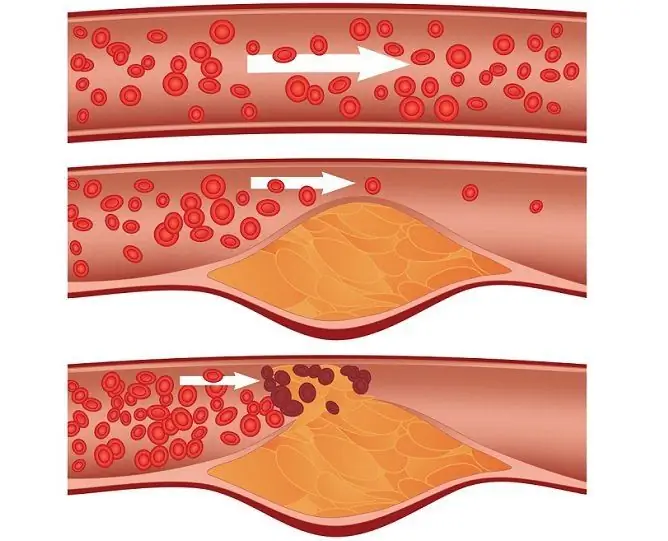- Author Rachel Wainwright [email protected].
- Public 2023-12-15 07:39.
- Last modified 2025-11-02 20:14.
Multiple sclerosis
General characteristics of the disease

Multiple sclerosis is a serious progressive disease with numerous lesions of the central nervous system.
There is a classification according to the type of disease course. According to her, they distinguish between malignant and benign forms of multiple sclerosis, as well as a special type of disease - opticomyelitis or Devik's disease.
The course of multiple sclerosis is considered benign if, 15 years after the manifestation of the first symptoms of multiple sclerosis, the patient has no signs of disability, despite the absence of specific treatment.
In the malignant form of the course of multiple sclerosis, the disease is characterized by rapid progression and can be fatal within 3-6 months.
Patients with multiple sclerosis of the rarest form, Devik's disease, suffer from selective damage to the optic nerves. The disease is far from always fatal, but blindness of one or both eyes rapidly develops with it, followed by the growing symptoms of myelitis (inflammation of the spinal cord).
Multiple sclerosis causes
To date, no reliable cause of multiple sclerosis has been identified. There is a hypothesis about a multifactorial etiology of the disease. Its supporters attribute the combined effect of genetic and external factors to the most likely causes of multiple sclerosis.
In favor of the genetic nature of the disease is indicated by the fact that multiple sclerosis is most common in people in certain regions of the Earth, in particular, in Scotland, Denmark, the Scandinavian countries and among the white population of the United States.
The external environment, as one of the possible causes of multiple sclerosis, is considered in connection with the data on the influence of endogenous factors on human health before puberty. The risk of developing multiple sclerosis is reduced if a person leaves a high-risk area before adolescence.
Heredity is another likely cause of multiple sclerosis. The risk of getting sick in a family with cases of multiple sclerosis in 1-3 degrees of relationship is 2-5%. However, the gene responsible for the development of the disease has never been found.
Herpes viruses, which trigger the body's autoimmune response in patients with multiple sclerosis, are also considered to be potentially dangerous factors. There is also evidence of the effect of immune suppressing hormones as one of the possible causes of multiple sclerosis.
However, it must be admitted that all these theories do not have a sufficient scientific basis.
Multiple sclerosis symptoms

Early symptoms of multiple sclerosis include rapid fatigue, unsteadiness of gait, imbalance and various types of sensitivity (temperature, tactile, vibration, etc.). Patients with multiple sclerosis at the initial stage of the disease often complain of decreased acuity and narrowing of the field of vision.
The early symptoms of multiple sclerosis are usually transient. Their occurrence often occurs against the background of a respiratory viral disease or significant overheating of the body. This can lead to underestimation of the severity of the symptoms of multiple sclerosis and a later diagnosis of the disease.
Against the background of the progression of the pathology in patients with multiple sclerosis, late signs of the disease appear:
- selective limb fatigue,
- muscle paresis,
- decreased visual acuity in one eye (a feeling of fog or a spot in front of the eye), double vision,
- dizziness,
- speech disorders,
- sphincter disorders (swallowing, urination, bowel movement).
The clinical picture of the disease can be described in more detail, only knowing the exact type of multiple sclerosis.
Types of multiple sclerosis
According to the international classification, it is customary to distinguish 4 main types of multiple sclerosis, which have different specifics of the manifestation of symptoms:
- remitting,
- secondary progressive,
- primary progressive,
- remitting-progressive.
For relapsing multiple sclerosis, there are distinct periods of exacerbation and remission. During an attack of the disease, there is a persistent exacerbation of symptoms of multiple sclerosis lasting up to 24 hours. For the next 30 days, the condition of the patient with multiple sclerosis is usually stable.
With a secondary progressive type of the disease, the neurological symptoms of multiple sclerosis increase abruptly during periods of exacerbation. They become more frequent and soon the periods of remission of the disease become less pronounced. The secondary progressive type of the disease develops in patients with remitting multiple sclerosis on average 10 years after the onset of the disease in the absence of treatment.
In primary progressive multiple sclerosis, symptoms increase rapidly from the onset of the disease. There are no periods of exacerbation and remission in this case.
Another type of disease, relapsing-progressive multiple sclerosis, is characterized by a sharp increase in symptoms during periods of attacks, starting in the early stages of the disease.
Multiple sclerosis diagnostics
Early diagnosis of multiple sclerosis is very important, as it prevents the rapid increase in symptoms and disability of the patient. However, due to the extensive clinical picture and transient symptoms, the diagnosis is usually made late.
On the other hand, overdiagnosis and too early the appointment of a specific therapy for a disease can also cause significant harm to human health. In addition to dynamic monitoring of the patient, the diagnosis of multiple sclerosis includes magnetic resonance imaging and immunological examination of cerebrospinal fluid.
Multiple sclerosis treatment

The high efficiency of the treatment of multiple sclerosis is one of the most pressing problems of modern neurology. Especially in connection with the fact that the methods of prevention and causes of multiple sclerosis are still unknown.
However, there are no special achievements in the field of treatment of multiple sclerosis. In the treatment of exacerbations of the disease, corticosteroids are usually used in individual dosages. Their goal is to reduce spinal cord inflammation and shorten the duration of an attack. Additionally, a patient with multiple sclerosis is prescribed antioxidants, antiplatelet agents, angioprotectors, etc. according to the general therapeutic scheme.
For the prevention of exacerbations in the treatment of multiple sclerosis, immunomodulators are used. They allow to reduce the frequency of periods of disease attack by 30%.
Symptomatic treatment of multiple sclerosis involves physical therapy to partially restore the patient's motor and sensory functions. To improve the quality of life of a patient with multiple sclerosis, restore social activity and normalize his mental state, psycho-rehabilitation sessions are conducted.
YouTube video related to the article:
The information is generalized and provided for informational purposes only. At the first sign of illness, see your doctor. Self-medication is hazardous to health!






